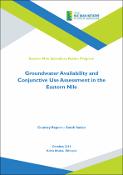Options
Groundwater Availability and Conjunctive Use Assessment in the Eastern Nile Country Report - South Sudan
Date Issued
2019-10
Status
Open Access
ENTRO Subjects
GROUND WATER
Sub basin
MAIN NILE
Country
Abstract
South Sudan extends from latitude 3o 30” N to approximately latitude 12o 15” N and from longitude 23o 30” E to longitude 36o E. It has an area of more than 644,330 km² with population of 11.3 million in 2013, which is predominantly rural. Nevertheless, the country is experiencing a high rate of urban growth. The system of government is decentralised, comprising of national and state levels; in addition to county, payam and boma as local levels.
It is rich in biodiversity, which includes swamplands; lush savannas; woodlands; rainforests; and special areas of mountainous vegetation that are home to many species of wildlife and that support a large number of livestock. Most of the inhabitants depend on farming, animal husbandry, fishing and the other natural harvests, catches and products for their livelihoods. Most of the government’s revenue is driven from petroleum sector; and very little is raised from nonoil revenues.
It is rich in biodiversity, which includes swamplands; lush savannas; woodlands; rainforests; and special areas of mountainous vegetation that are home to many species of wildlife and that support a large number of livestock. Most of the inhabitants depend on farming, animal husbandry, fishing and the other natural harvests, catches and products for their livelihoods. Most of the government’s revenue is driven from petroleum sector; and very little is raised from nonoil revenues.
Subjects
File(s)
Loading...
Name
Groundwater Availability & Conjunctive Use Assessment in the EN -South Sudan Country Report.pdf
Size
13.86 MB
Format
Checksum